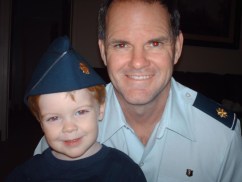
Photos and text used with permission of
Dr. David Tharp.
When I volunteered to serve in Afghanistan through the Air Force in a NATO billet in Kandahar, the last thing I thought of was being medavaced to Landstuhl Regional Medical Center (LRMC). But, we often end up in places we never imagined.
As a clinical psychologist, I was serving in the capacity as a medical advisor to the Commander Kandahar Airfield (COMKAF). My job was to liaison between the sixty million dollar state-of-the-art medical facility that treats our most severely wounded soldiers in Regional Command South (RCS) and the Commander of KAF (NATO’s busiest single runway in the world). I was also responsible for the medical assets of 29 countries and served as the Preventative Medicine and Environmental Engineer. Coordinating medical assets at Kandahar Airfield and ensuring the safety of 30,000 people was of primary importance and one I took very seriously. Unfortunately, it was also my job to identify any casualties on base as we took indirect fire from insurgents on a daily basis during my six month plus tour. Let’s just say, I never imagined being triple-hatted in a war zone, responsible for the coordination of an entire war town’s medical assets but, then, I did volunteer for the adventure of a lifetime.
During my tour of duty, I experienced a neurological attack of my central nervous system – Acute Transverse Myelitis (which was originally thought to be Multiple Sclerosis). With four weeks remaining in theater, I lost all feeling except numbness and tingling below my chest to my toes. It made walking, running, and other movement quite challenging. I never imagined that I would experience something so debilitating that it literally made it impossible to walk to work every day, let alone run from rocket attacks. Thank God for the insight of our U.S. Navy personnel to place a neurologist right smack in the middle of Kandahar. Although I was responsible for helping to coordinate an MRI into Kandahar, it hadn’t made it yet so assessments had to be made through symptomatology. One month later, moving through the MEDEVAC system that I helped coordinate into KAF, I ended up at LRMC and finally the U.S. Air Force Academy to finalize my treatment.
After redeployment back to the United States and returning to my job in the Veterans Affairs, I was asked to participate in a CDMRP Spinal Cord Injury Research Program’s review panel as a Consumer Reviewer (CR). Let me just say - what an amazing experience! Working for the VISN 17 Center of Excellence for Research on Returning War Veterans and as an Assistant Professor at Texas A&M Health Science Center College of Medicine, I am well versed in research. What I wasn’t well versed in was being the patient in all of this. I never asked to be a patient but it was my turn. I had the opportunity to directly feel the impacts of war and what the stress and strain of 16 hour days with no days off can do to a body. But compared to others, this was nothing. So, when asked to do my part as a CR to provide my insights into what research can and should focus on, it was an honor I could not refuse. This is an opportunity where Congress has mandated research and actually cares about the direct impact of that research. The opportunity of impact, the chance to discuss treatment ideas, the honor of rating how research could and might impact veterans and their families’ lives …who could ask for more. Well, that and having the opportunity to meet highly respected professionals and share your insights is incalculable. So, that being said, I would STRONGLY recommend anyone who has been through the types of things that CDMRP researches, should stand up and become a CR. The CR brings an incredibly robust perspective to research that has direct impact on what is not only funded but can provide insight that only those who have been there can bring. Once again, as a CR, I am grateful that I got a chance to make an impact on something I never imagined!
Last updated Thursday, May 26, 2022














